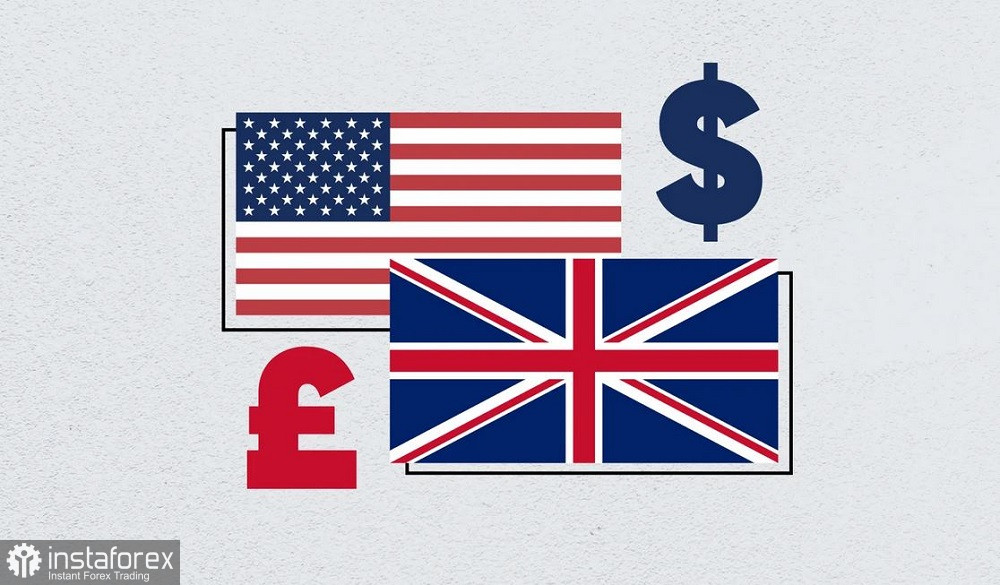The GBP/USD currency pair sharply depreciated at the end of last week. In just two days, the British currency lost 200 points, dropping from 1.2336 to 1.2121. This price movement was primarily driven by the strengthening of the greenback, as traders interpreted American inflation reports in favor of the dollar. The pound couldn't respond effectively. The economic data published last Thursday regarding the growth of the British economy painted a rather contradictory picture. While the GDP increased minimally, industrial production decreased. As a result, the British pound obediently followed the trend of the greenback, losing more than 200 points.
This week, the situation can change significantly.

Firstly, 12 Federal Reserve officials, including Federal Reserve Chairman Jerome Powell, are expected to give a speech in the coming days. If they maintain a cautious stance and focus on the slowing core consumer price index and the core PCE index (while ignoring the rise in producer price index and overall CPI), the dollar may come under pressure again. In such a scenario, the chances of a rate hike in November will decrease to zero. Hawkish expectations regarding December prospects will also weaken.
Secondly, this week in the UK, a significant block of macroeconomic data related to the labor market and inflation will be published. If the indicators fall into the "green zone" (especially with regard to inflation), the British pound could regain its strength.
It is important to note that the International Monetary Fund (IMF) forecasted further tightening of the monetary policy by the Bank of England last week. According to the published forecast, the English regulator will have to raise the interest rate again "due to sustained high inflation in the country." This hawkish forecast contrasts with the relatively soft rhetoric of the central bank, which, in its last meeting, maintained the policy parameters unchanged. Out of the nine members of the Monetary Policy Committee, five voted against raising the rate, while four voted in favor of a 25-point increase, taking it to 5.5%.
The accompanying statement also carried a cautious and rather pessimistic tone. In particular, the Bank of England lowered the GDP growth forecast for the UK to 0.1% (the previous forecast was at 0.4%). Members of the central bank expressed concern about the declining industrial production in the UK and the steadily decreasing number of job vacancies.
Given this disposition, it's difficult to overstate the importance of the macroeconomic reports that will be published this week.
So, on October 17, we will find out the key labor market data. According to forecasts, the unemployment rate will increase to 4.4%. In this case, we can confidently speak of a negative trend, as unemployment has been consistently rising for the past three months, climbing from 3.8% (April) to 4.3% (July). August may become the fourth month of this upward trend. The number of jobless claims is expected to increase by 2,300 (for comparison, in the previous month, the increase was 900). However, average wages are expected to decrease slightly. The level of average earnings (including bonuses) has been increasing consistently for five months, reaching 8.5%. In August, this indicator is expected to slow down slightly to 8.3%. Excluding bonus payments, the indicator should remain at the same level as the previous month (7.8%).
On Wednesday, October 18, key data on British inflation will be published.
According to preliminary forecasts, the overall Consumer Price Index (CPI) in September may slow down to 6.6% YoY. The indicator has been declining consistently since February of this year (when it was at 10.4%). The core CPI, excluding energy and food prices, is also expected to demonstrate a downward trend, decreasing to 6.0%. In this case, the indicator will reach an 8-month low. The Retail Price Index (RPI) is expected to drop to 8.9%, the lowest level since March 2022. Producer Price Index (PPI) and Output Price Index (OPI) are also expected to decrease (to -2.9% and -0.6% respectively).
Thus, according to forecasts, inflation should show signs of further slowing down. If the indicators meet or exceed the forecasted levels (let alone entering the "red zone"), the pound in its pair with the dollar will continue to follow the U.S. currency (which, in turn, will react to the rhetoric of the Federal Reserve members). But if the reports show a "green" trend, the pound will receive significant support, as the question of raising the Bank of England's interest rate will return to the agenda.
From a technical perspective, the GBP/USD pair on the D1 timeframe is located between the middle and lower lines of the Bollinger Bands indicator, and below all the lines of the Ichimoku indicator, including the Kumo cloud. It is advisable to consider long positions only after the price surpasses the 1.2200 target, which coincides with the middle line of the Bollinger Bands, corresponding to the Tenkan-sen line on the daily chart.
 English
English 
 Русский
Русский Bahasa Indonesia
Bahasa Indonesia Bahasa Malay
Bahasa Malay ไทย
ไทย Español
Español Deutsch
Deutsch Български
Български Français
Français Tiếng Việt
Tiếng Việt 中文
中文 বাংলা
বাংলা हिन्दी
हिन्दी Čeština
Čeština Українська
Українська Română
Română

